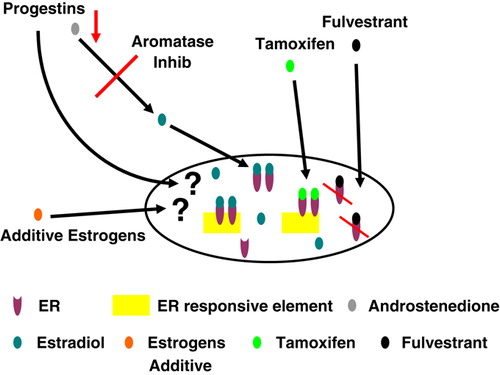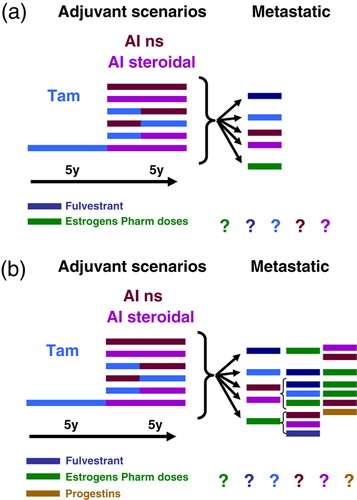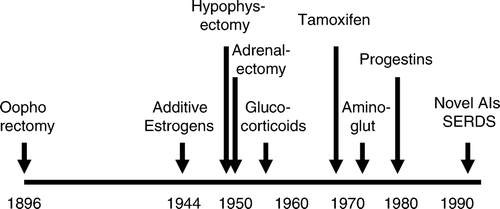Figures & data
Figure 2. Potential effects of different endocrine treatment options on hormonal disposition and mechanisms of action in breast cancer cells.

Figure 3. Growth-stimulation curves of wild-type MCF-7 cells and long-term estrogen deprived cells in culture. Notably, following long-term estrogen deprivation, these cells may achieve maximal growth-stimulation by a concentration of 1:1 000 to 1:10 000 concentration required for wild-type cells. Notice the “bell-shaped curve” moves to the left, meaning that estrogens at concentrations causing optimal growth-stimulation in wild-type cells now may inhibit growth of cells undergoing long-term estrogen deprivation. Adapted with permission from reference Citation[86].
![Figure 3. Growth-stimulation curves of wild-type MCF-7 cells and long-term estrogen deprived cells in culture. Notably, following long-term estrogen deprivation, these cells may achieve maximal growth-stimulation by a concentration of 1:1 000 to 1:10 000 concentration required for wild-type cells. Notice the “bell-shaped curve” moves to the left, meaning that estrogens at concentrations causing optimal growth-stimulation in wild-type cells now may inhibit growth of cells undergoing long-term estrogen deprivation. Adapted with permission from reference Citation[86].](/cms/asset/903a9a34-fbc3-4e2d-a3ac-abcb5b32fbb4/ionc_a_411954_f0003_b.jpg)
Figure 4. “The estrogen suppression paradox”. This figure illustrates average plasma estradiol levels in premenopausal women and after ovarian ablation (left), normal postmenopausal women and after exposure to aromatase inhibitors (middle), and patients previously having estrogen suppression through adrenalectomy or hypophysectomy Citation[92] exposed to aromatase inhibitors (right).
![Figure 4. “The estrogen suppression paradox”. This figure illustrates average plasma estradiol levels in premenopausal women and after ovarian ablation (left), normal postmenopausal women and after exposure to aromatase inhibitors (middle), and patients previously having estrogen suppression through adrenalectomy or hypophysectomy Citation[92] exposed to aromatase inhibitors (right).](/cms/asset/7475a48b-91c7-4945-b61a-69a194b160d1/ionc_a_411954_f0004_b.jpg)
Figure 5. a) Clinical scenario for most postmenopausal patients harbouring ER+ tumours relapsing after adjuvant therapy involving aromatase inhibitors. We lack data whether tamoxifen or an aromatase inhibitor should be re-implemented in this setting or the patients alternatively should be exposed to compounds as fulvestrants or estrogen in pharmacological doses. b) The scenario become even more complicated considering second and potential third-line endocrine therapy; in this setting, there is no scientific evidence suggesting the one sequence as compared to the others.

